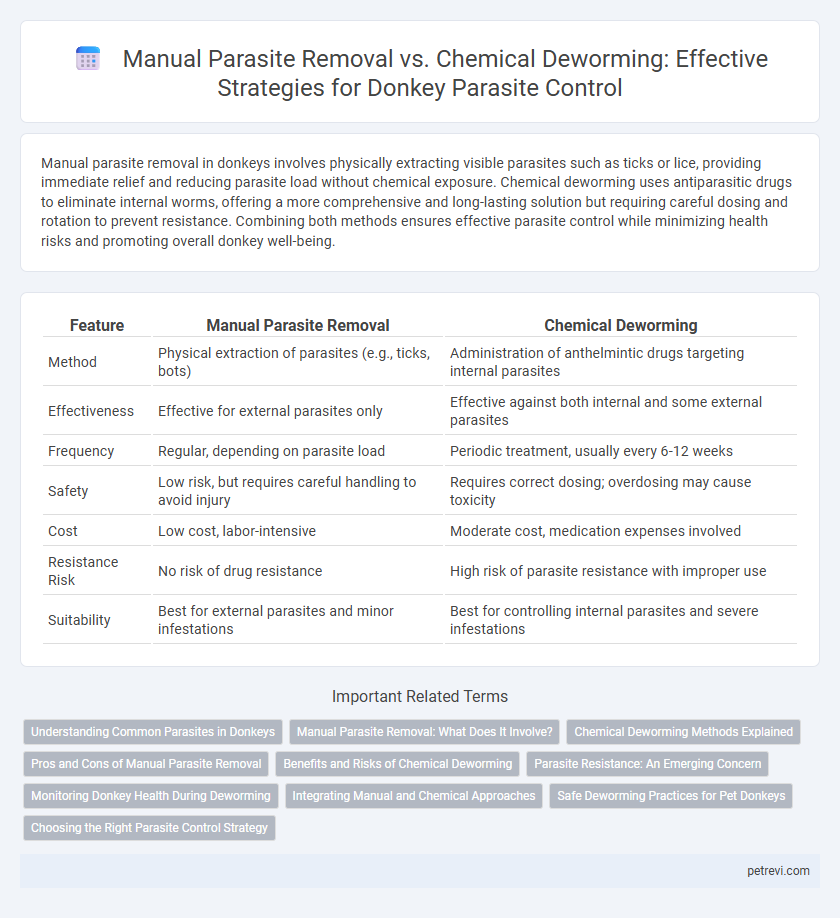Manual parasite removal in donkeys involves physically extracting visible parasites such as ticks or lice, providing immediate relief and reducing parasite load without chemical exposure. Chemical deworming uses antiparasitic drugs to eliminate internal worms, offering a more comprehensive and long-lasting solution but requiring careful dosing and rotation to prevent resistance. Combining both methods ensures effective parasite control while minimizing health risks and promoting overall donkey well-being.
Table of Comparison
| Feature | Manual Parasite Removal | Chemical Deworming |
|---|---|---|
| Method | Physical extraction of parasites (e.g., ticks, bots) | Administration of anthelmintic drugs targeting internal parasites |
| Effectiveness | Effective for external parasites only | Effective against both internal and some external parasites |
| Frequency | Regular, depending on parasite load | Periodic treatment, usually every 6-12 weeks |
| Safety | Low risk, but requires careful handling to avoid injury | Requires correct dosing; overdosing may cause toxicity |
| Cost | Low cost, labor-intensive | Moderate cost, medication expenses involved |
| Resistance Risk | No risk of drug resistance | High risk of parasite resistance with improper use |
| Suitability | Best for external parasites and minor infestations | Best for controlling internal parasites and severe infestations |
Understanding Common Parasites in Donkeys
Common parasites affecting donkeys include strongyles, tapeworms, and roundworms, which can cause weight loss, colic, and anemia. Manual parasite removal, such as fecal egg count monitoring, helps identify parasite load and supports targeted treatments. Chemical deworming with anthelmintics offers effective control but requires careful management to prevent resistance and ensure donkey health.
Manual Parasite Removal: What Does It Involve?
Manual parasite removal in donkeys involves physically extracting parasites such as ticks, lice, and botfly larvae from the animal's skin and coat using tools like combs, tweezers, or by hand. This method requires regular inspection and immediate removal to prevent infestation and reduce parasite load without chemical intervention. Manual removal targets external parasites directly, minimizing chemical residues and resistance issues common with chemical deworming agents.
Chemical Deworming Methods Explained
Chemical deworming methods for donkey parasite control primarily involve administering anthelmintic drugs such as ivermectin, fenbendazole, and praziquantel, which target a broad spectrum of internal parasites including strongyles, roundworms, and tapeworms. These medications work by disrupting the parasite's nervous system or metabolic processes, leading to their death and expulsion from the donkey's digestive tract. Proper dosing schedules and rotation of drug classes are essential to prevent anthelmintic resistance and ensure effective long-term parasite management in donkeys.
Pros and Cons of Manual Parasite Removal
Manual parasite removal in donkeys allows for targeted extraction of visible parasites such as ticks and botfly larvae, reducing immediate parasite load without drug resistance risk. This method requires regular, labor-intensive inspections and may miss microscopic or internal parasites, limiting its effectiveness. While chemical deworming addresses a broader range of parasites systemically, manual removal is a natural, residue-free approach beneficial in organic or sensitive cases.
Benefits and Risks of Chemical Deworming
Chemical deworming provides a fast and broad-spectrum solution for controlling internal parasites in donkeys, effectively reducing worm burdens and improving overall health. However, frequent use can lead to parasite resistance, diminishing long-term efficacy and requiring higher doses or alternative treatments. Risks also include potential side effects such as colic, toxicity, and disruption of gut flora, making it crucial to balance chemical use with careful management and monitoring.
Parasite Resistance: An Emerging Concern
Manual parasite removal for donkeys reduces the risk of developing parasite resistance compared to chemical deworming, which relies heavily on anthelmintic drugs. Overuse of chemical dewormers has led to widespread resistance in common donkey parasites such as strongyles and roundworms, diminishing treatment effectiveness. Implementing integrated parasite management combining manual removal and targeted chemical use helps mitigate resistance and ensures sustainable parasite control.
Monitoring Donkey Health During Deworming
Regular monitoring of donkey health during deworming involves observing changes in appetite, weight, and coat condition to promptly identify adverse reactions. Manual parasite removal allows for targeted treatment by physically extracting parasites, reducing chemical exposure. Chemical deworming requires careful dosage and timing to prevent resistance and ensure effective parasite elimination while minimizing health risks.
Integrating Manual and Chemical Approaches
Integrating manual parasite removal with chemical deworming enhances donkey parasite control by combining physical removal of visible parasites with targeted anthelmintic treatments, reducing parasite resistance and improving overall health. Manual methods such as regular grooming and fecal egg counts help identify infestations early, while chemical dewormers like ivermectin or fenbendazole effectively eliminate internal parasites. This combined approach promotes sustainable parasite management, minimizes drug resistance, and supports the donkey's immune system.
Safe Deworming Practices for Pet Donkeys
Manual parasite removal in donkeys involves physically extracting parasites such as ticks and botfly larvae, promoting immediate relief without reliance on chemicals, which is especially beneficial for pet donkeys sensitive to medication. Chemical deworming uses anthelmintic drugs like ivermectin or fenbendazole, effectively targeting internal parasites, but requires careful dosing and rotation to prevent resistance and ensure safety. Safe deworming practices for pet donkeys emphasize regular fecal egg count monitoring, avoiding overuse of chemicals, and combining manual removal with strategic anthelmintic treatments to maintain optimal health.
Choosing the Right Parasite Control Strategy
Manual parasite removal in donkeys involves physical extraction of visible worms and larvae, offering immediate relief but requiring regular and careful inspection. Chemical deworming uses targeted anthelmintic drugs such as ivermectin or fenbendazole to eliminate internal parasites effectively but may contribute to resistance if overused. Selecting the appropriate parasite control strategy depends on factors like parasite load, donkey health status, pasture contamination, and veterinary guidance to balance efficacy and sustainability.
Manual Parasite Removal vs Chemical Deworming for Donkey Parasite Control Infographic

 petrevi.com
petrevi.com